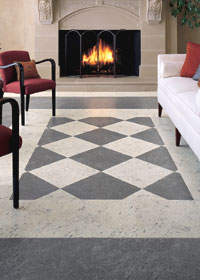Resilient
It’s easy to shrug off the word “resilient” and believe that it’s simply another term for vinyl. While that’s a basically correct assumption, there are more materials in the resilient family that have efficiently and expertly served both residential and commercial customers for decades, such as linoleum, rubber, cork, polyurethane and even asphalt.
A resilient floor has a great history of performance because of its affordability, easy maintenance and safety factors, as well as its unlimited array of colors, styles, textures and patterns. The only negative associated with resilient flooring is its tendency to wear faster than other hard-surfaced floors like hardwood or laminate. Expect to replace a resilent about every ten years.
Versatility to meet any project
Resilient is king in terms of variety of appearances. Like laminates, resilient floors can mimic wood, stone, ceramic and even brick. If your project is a high-traffic residential or commercial area, today’s resilients are manufactured to withstand the pressure and not tear or stain as easily as earlier versions.
Flexibility to cover any surface
Unlike carpeting or hardwoods, resilients can be installed over most any existing floor, including wood, other resilients and concrete. The only necessary component is that the floor must be flat and without noticeable grooves, gouges or bumps.
About Vinyl
A vinyl floor can be installed in sheets or tiles, depending upon the style. Sheet vinyl is separated by residential and commercial grades and further designated with terms such as “inlaid construction,” “rotogravure construction” and “wearlayer.”
- Inlaid: The veteran of the group, inlaid vinyl sheeting usually sports the traditional symmetrical patterns commonly associated with vinyl flooring. Inlaid has an easy-to-maintain clear wearlayer coating that protects the material from wear.
- Rotogravure: This relatively new product allows for a wide spectrum of designs and colors to be created in vinyl flooring. Like the inlaid, however, the clear coating protects the artwork.
- Wearlayer: The thicker the protective layer, the more expensive the product will be, but the longer the flooring will last. Wearlayers are the shield between your floor and traffic hazards, such as spills, stains, scratches, rips and tears. Inexpensive floors may stain more easily because the wearlayer isn’t as strong as its more pricey counterparts. Your budget and your expected use of the floor should dictate choices in wearlayer.
About Linoleum
While the linoleum floor is part of the resilient family, it is not part of the vinyl family. Instead, linoleum is a natural product that needs a completely different installation and maintenance program from its resilient cousin, vinyl. Linoleum is part wood, part stone and part grass, tied together with resins and oils. Linoleum has been around for more than 150 years, but new advances in colors and styles are making this natural product popular again.
Linoleum is almost as versatile as vinyl in the type of colors and patterns it offers, and both commercial and residential consumers find linoleum to be exactly what they want and need for their projects. Linoleum can be installed in either a sheet or tile format. The best assets of linoleum are found most often in commercial settings, because the fibers used to build a linoleum floor resist burning and wear and can be kept highly sanitary more easily than other flooring choices.
Because linoleum is made from natural products, a process called “blooming” will occur to a linoleum floor. Blooming means the floor changes color slightly because of exposure to light. It doesn’t fade, but rather it becomes its natural color. Conversely, if a section of linoleum is protected from light, the natural fibers are unable to bloom, and yellowing will occur. The floor readjusts itself from this yellowing once that area is exposed to light.
About Rubber
Environmentally-conscious consumers have a segment of the resilient family to choose from: rubber flooring. Recycled tires are used to create flooring in many colors and designs, in both sheets or tiles, that are typically used in commercial environments. The off-the-chart durability factor sells rubber flooring for high-traffic areas. Rubber flooring also offers good slip resistance and a cushioned surface for falls, which is appealing to safety-conscious buyers.
About Cork
Another resilient surface is cork flooring. This surface was popular in the 1950s and 60s and is experiencing a comeback with designers and environmentally-conscious homeowners. A cork floor is easy to clean and maintain and is available in tiles or planks. Its natural fibers allow for superior comfort and extended durability. Because of its natural makeup, cork flooring resists mold and mildew and is a good choice for commercial settings needing high sanitization or homeowners with allergies.
Getting your resilient floor installed
It is recommended to have an INSTALL Indiana/Kentucky/Ohio contractor install your resilient floor. These experts have, collectively, hundreds of years of experience and are ready and available to help you. These contractors have the support of an international training program to ensure that every facet of resilient flooring installation is mastered by INSTALL Indiana/Kentucky/Ohio professionals. These contractors will not only see to it that the floor is installed properly, but they will teach you how to care for the floor.
Resilient flooring is typically installed using a variety of adhesives that are made specifically for the type and style of resilient floor to be installed. Some resilients, including vinyl and asphalt, come in tile format and some already have self-adhesive backing. Again, it’s a wise move to let an INSTALL Indiana/Kentucky/Ohio professional install your resilient floor, so that you can benefit from the years of wear the floor is meant to provide.
Need more information?
Access the professionalism of the international INSTALL network. Visit the web sites of INSTALL partners:

